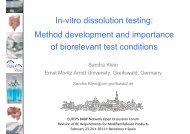2011 Anniversary Yearbook - EUFEPS today and history
2011 Anniversary Yearbook - EUFEPS today and history
2011 Anniversary Yearbook - EUFEPS today and history
You also want an ePaper? Increase the reach of your titles
YUMPU automatically turns print PDFs into web optimized ePapers that Google loves.
location for biopharmaceutical research<br />
<strong>and</strong> development. The stakeholders<br />
acknowledged the value of industry<br />
leadership, the importance of the four<br />
topics of the Strategic Research Agenda,<br />
<strong>and</strong> the pre-competitive approach. The<br />
public-private collaboration as support for<br />
the platform was also positively received.<br />
Education & Training is a critical<br />
component of the Strategic Research<br />
Agenda, <strong>and</strong> the need for a pan-European<br />
organisation of academic institutions<br />
engaging in drug development became<br />
obvious.<br />
Stakeholder Input<br />
For Academia, improvements are needed<br />
in the critical mass of research groups,<br />
scientist <strong>and</strong> student mobility, new<br />
technologies, cross-disciplinary issues<br />
<strong>and</strong> positive public perception.<br />
The Clinical Sector’s contribution to<br />
European competitiveness builds on the<br />
quality of clinical research infrastructures,<br />
capacity of investigation, databases <strong>and</strong><br />
biobanks. In addition, the industry needs<br />
Europe-wide networks to make clinical<br />
research more efficient.<br />
For SMEs, weaknesses include<br />
inefficient technology transfer from basic<br />
research, too few management experts<br />
<strong>and</strong> broadly educated drug developers, as<br />
well as lack of existing accessible biology<br />
facilities, GMP units <strong>and</strong> toxicology<br />
databases.<br />
For Regulatory, more research,<br />
conducted at the agencies, was<br />
recommended, e.g. by compilation of<br />
relevant generic data from old application<br />
files. Openness to modern methodologies<br />
<strong>and</strong> reorientation of the regulatory<br />
assessment dem<strong>and</strong>s were also seen as<br />
important.<br />
Learned Societies, which already<br />
organise scientists from academia,<br />
industry, the regulatory agencies <strong>and</strong><br />
clinical fields, have a long tradition,<br />
based on a discipline-oriented European<br />
structure. However, they will need to create<br />
a European organisation, which covers<br />
the complete drug development process.<br />
They could contribute by participating in<br />
a number of the coordination functions<br />
needed for the forthcoming Platform.<br />
Active involvement of Patients <strong>and</strong><br />
Patients’ Associations will promote drug<br />
development in line with patients’ needs,<br />
foster their enrolment in studies, <strong>and</strong><br />
encourage the implementation of new<br />
treatment strategies.<br />
First reporting available<br />
A summary outcomes report from<br />
the workshop is already posted on the<br />
<strong>EUFEPS</strong> website; www.eufeps.org (New<br />
Safe Medicines Faster). A full report will<br />
be issued in the summer, at the same<br />
time as the Strategic Research Agenda is<br />
published, together with the outcomes of<br />
the series of the four workshops regarding<br />
Efficacy, Safety, Knowledge Management<br />
<strong>and</strong> Training & Education.<br />
Innovative Medicines replace New<br />
Safe Medicines Faster<br />
The heavy involvement of EFPIA <strong>and</strong> EU<br />
in drug science R&D means that you may<br />
not hear so much about the well-known<br />
“New Safe Medicine Faster” in the future,<br />
but instead about “Innovative Medicines<br />
XLIII<br />
Project for the Citizens of Europe”. It is<br />
interesting to note that the new initiative<br />
covers many of the same issues as<br />
<strong>EUFEPS</strong> presented in 1999;<br />
• Optimising the drug development<br />
process by removing bottlenecks<br />
• Giving Europe the best drug<br />
development system in the world by<br />
early introduction of state-of-the-art<br />
technologies<br />
• Rethinking all regulatory procedures<br />
from a science-based view to minimize<br />
bureaucracy <strong>and</strong> maximize validity<br />
Further visions<br />
The wording is different but the content<br />
is along the same lines. The current<br />
platform leadership now rests with EFPIA<br />
<strong>and</strong> EU, <strong>and</strong> <strong>EUFEPS</strong> is in the loop as a<br />
stakeholder. <strong>EUFEPS</strong> is also a consortium<br />
member of the EU-supported integrated<br />
research project InnoMed that will bring<br />
the initiative further forward. As an<br />
ambassador <strong>and</strong> promoter of the platform<br />
initiative, Hans H. Lindén plans to visit to<br />
several of the European stakeholders this<br />
autumn.<br />
In addition, <strong>EUFEPS</strong> is creating<br />
further visions on how pharmaceutical<br />
sciences can be advanced in Europe. A<br />
number of working parties have also been<br />
established to transform such visions into<br />
workable strategies, to be presented <strong>and</strong><br />
discussed at the forthcoming <strong>EUFEPS</strong><br />
Council in September this year, in<br />
Hungary.




